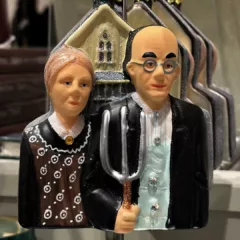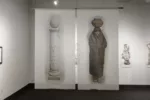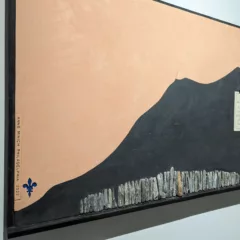Mel Bochner; In the Tower at the National Gallery of Art (NGA, through April 29, 2012) includes thirty works on paper from the 1960s, most from the group known as Thesaurus portraits, and a room full of recent, large, colorful canvases for which the artist returned to the thesaurus as a starting-point. The use of language and block letters may suggest a conceptual and systematic order and rationality behind these forty years’ work; but dressed up as they are in the protective pedantry of word lists and generic typeface, they instead reflect the personal, idiosyncratic, probing, always intelligent and often humorous stream of Bochner’s thought. The recent paintings also reveal him as a sensitive colorist, with a range from restrained earth colors to acid synthetics.
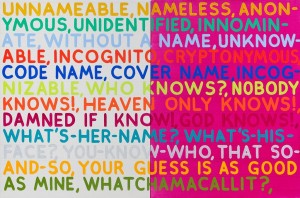
The artist turned to the thesaurus in the mid 1960s for a series of portraits of himself and other artists, in a lineage of abstract portraiture going back to Francis Picabia and Charles Demuth. They employ purposeful juxtapositions, unlikely to be found in dictionary or thesaurus: Portrait of Eva Hesse (1966) consists of words describing her methods: ENCLOSE, BIND, WRAP, and then SWADDLE, ENSHROUD – from birth to death.
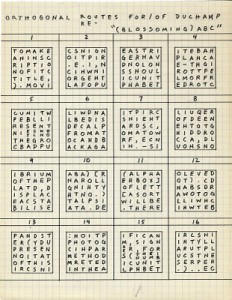
Bochner’s humor appears throughout: in Minimal Art: The Movie (1966), where he casts Fred Astair as Robert Morris and Jack Palance as Robert Smithson, and in Unnameable (2003), where he juxtaposes DAMNED IF I KNOW with GOD KNOWS! The polychrome word paintings reflect Bochner’s appreciation for colorful, vernacular expressions: the synonyms for Money (2005) suggest food: BREAD, PEANUTS, GRAVY, SMALL POTATOES, while those for Die (2005) equate the ultimate state of inaction with a broad range of actions: PASS AWAY, DROP DEAD, PULL THE PLUG, BUY THE FARM, PUNCH YOUR TICKET, KICK THE BUCKET, PUSH UP DAISIES, SCREW THE POOCH.
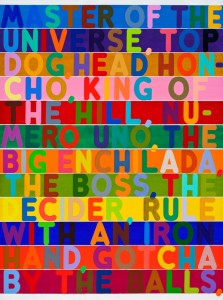
Sometimes each line, word or expression is a single color; in the most recent paintings each letter is differently colored, so they have the flickering quality of moving text on a live video feed. The viewer who takes the time to follow Bochner’s word lists may find them continuing mentally, in a potentially endless word stream, a reminder that language is one way we attempt to create clarity within the messiness of life.
Material Interventions
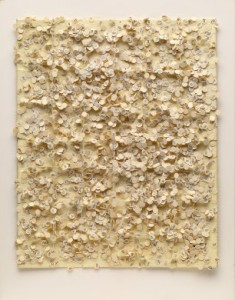
A small gallery next to those showing early modernist art has a beautiful, sensitively-installed exhibition of nine works, called Material Interventions. The label states that the work was designed to engage senses through their distinctive materiality, which is the curator’s way of saying they use unconventional materials and much of the work has a seductive tactility, as if asking to be touched. They include a sensuous, wax, wall piece by Linda Benglis, an entrancing, early collage by Howardena Pindell, of tiny, punched paper circles arranged in a complex, three-dimensional surface, Leslie Dills’ child-sized paper dress, printed with text by Emily Dickinson, Amila Rubiku’s drawing, partially made with embroidery, and one of Annette Messager’s hanging constructions of many, small photo details and inscriptions, suspended on the wall by string.
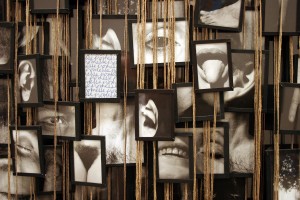
If it’s not obvious from that list, a unifying aspect of most of the work, and one, it seems, not to be whispered in the NGA, is the influence of feminism. This includes the references to traditional women’s handicraft (most obviously in the Dill and Rubiku) as well as the rejection of conventional art materials, that women associated with a male art tradition from which they had been excluded. The works also represent a challenge to museum departments that is common to much art since the 1960s, with works on paper that are neither drawings, prints, nor photography, wall-hung work that isn’t quite painting, and work incorporating photography that doesn’t fit comfortably in the photography department. The exhibition is certainly the most sensitive expression of feminist concerns I’ve seen at the Gallery, and an intimate pleasure to view.
In the Collection Galleries
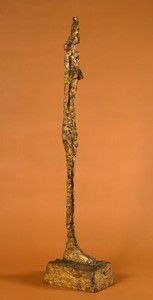
Walking through the other galleries on the second floor of the West Building, I saw a number of intriguing works from the collection that I didn’t recognize (or didn’t remember), which were worthy of note. If you descend the stairs from the Tower Gallery, the first room you enter has a group of European paintings and sculpture from the 1950s which form a serious and cohesive group. They are especially valuable because most of the artists are unknown, or known but not seen, in the U.S.. Arrayed around a group of Giacommetti sculptures are paintings by Dubuffet, Manolo Millares (an irregular canvas, both scarred and torn), Pierre Soulages (with rich paint troweled over a scraped surface), Gaston Novelli (a white monochrome from 1959, not long after Rauschenberg’s white paintings which were first exhibited in 1953), Jean Fautrier, and Mimmo Rotella. European writers and filmmakers of the 50s are better known than their contemporaries in the visual arts, a field where U.S. xenophobia has blinkered our vision. This gallery forms a good introduction to their answers about how to make art after the experiences of World War II.
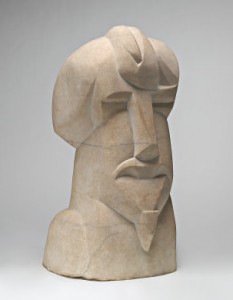
Elsewhere on the same floor I discovered Henri Gaudier-Brzeska’s stunning, marble bust of Ezra Pound, carved on gigantic scale normally associated with absolutist rulers, not poets;
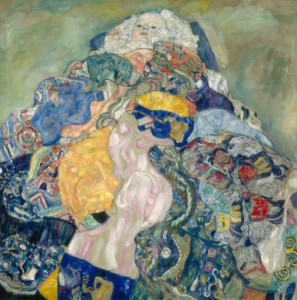
a Gustav Klimt of seemingly-abstract composition, which on close view revealed a tiny head of an infant at the top, almost entirely obscured by the riotous patchwork of a quilt;
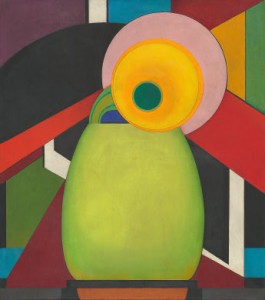
and a painting by Edward Steichen, the only one iving, because in 1923 the artist destroyed all the paintings in his possession, after which he would be known exclusively for his photography. I’d love to know what else the NGA has hidden in its store-rooms.


